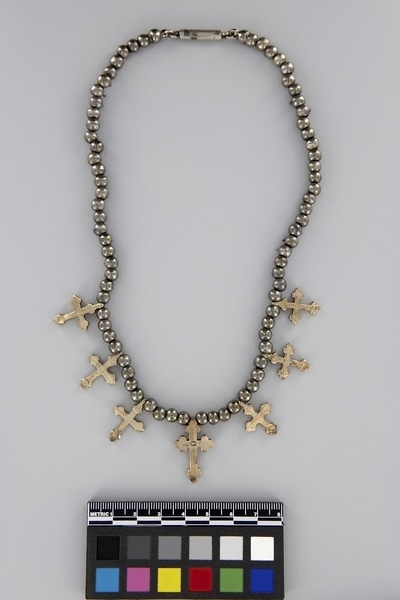Necklace Item Number: 1590/124 from the MOA: University of British Columbia

Description
Necklace with handmade silver beads and seven gold-coloured solid crosses along the bottom. Each cross has zigzag engraving and is separated by four beads. The cross in the middle is slightly larger. Each cross has a maker's mark.
History Of Use
Silver ornaments represent an important part of early exchange between Europeans, including fur traders, and First Nations people, especially in eastern and central Canada and the U.S.A. Initially, the main source of silver was British, French and Spanish coins. Most ornaments were produced by silversmiths of European origin in North America and Europe, and were actively traded only from 1760 to 1821. By the mid-18th century silver objects were produced in New England, Quebec and Montreal. Silver was used by First Nations people as a sign of rank. Silver ornaments in these styles continue to be produced by native silversmiths in central Canada and the USA. The cross was the oldest form of trade silver, introduced by French missionaries to North America for presentation to converts. Crosses were later used for trade with no religious connotations. The Latin cross has a single bar. Technique is not confirmed by a specialist. References cited refer to Trade Silver in general for the most part, rather than specific objects.
Specific Techniques
Roulette engraving produces a uniform zigzag, an identifying feature of this technique, and is created by using a revolving disk with sharp teeth.
Cultural Context
trade; personal decoration; status
Item History
- Made by Robert Cruickshank (Manufacturer) in Montreal, Quebec, Canada between 1760 and 1821
- Owned by Kathleen E. Reif before September 9, 1993
- Received from Kathleen E. Reif (Donor) on September 9, 1993
What
Who
- Culture
- Eastern Woodlands
- Creator
- Robert Cruickshank (Manufacturer)
- Previous Owner
- Kathleen E. Reif
- Received from
- Kathleen E. Reif (Donor)
Where
- Holding Institution
- MOA: University of British Columbia
- Made in
- Montreal, Quebec, Canada
When
- Creation Date
- between 1760 and 1821
- Ownership Date
- before September 9, 1993
- Acquisition Date
- on September 9, 1993
Other
- Item Classes
- metalwork
- Condition
- good
- Accession Number
- 1590/0124